Body Service and Adjustments - Truck
Door Adjustment
Doors are adjusted by shifting the door end of hinges, Fig. 321, where attached to the door. Attachment is made by screws which thread into a floating plate at each hinge. Loosen the attaching screws to shift the door either vertically or horizontally. Do not attempt to spring the hinges to improve door fitting. The combination door support latch pin and dovetail is attached to the pillar by screws threaded into a floating plate. Adjustment may be made by loosening the screws to allow shifting of the assembly. Use care in positioning this assembly. If it is located too far in it will be necessary to slam the door and the remote control button will be hard to operate - if too far out the door will be loose horizontally.
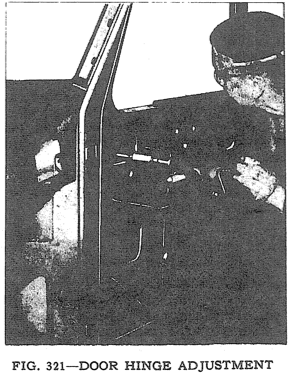
Door Striker Plate
To prevent the door opening in the safety latched position, the door striker wedge, Fig. 322, must be properly positioned in relation to the cam surface of the lock toggle. Improper safety latched position, as shown in Fig. 322, will permit the toggle to override the striker pin, causing the door to open. The striker must be positioned so that the door lock toggle will be held securely in engagement with the striker pin. The top or wedge end of the striker plate must be moved outward until the wedge firmly contacts the cam surface of the lock toggle, exerting sufficient pressure to prevent the toggle from overriding the striker pin. This may be accomplished by placing a suitable driver against the upper inside edge of the striker plate and with a hammer strike the driver to move the plate outward slightly. The safety latch operation must be checked intermittently with the repositioning of the striker until the correct position is obtained. The striker plate to pillar attaching screws must be securely tightened after the striker plate has been properly positioned.
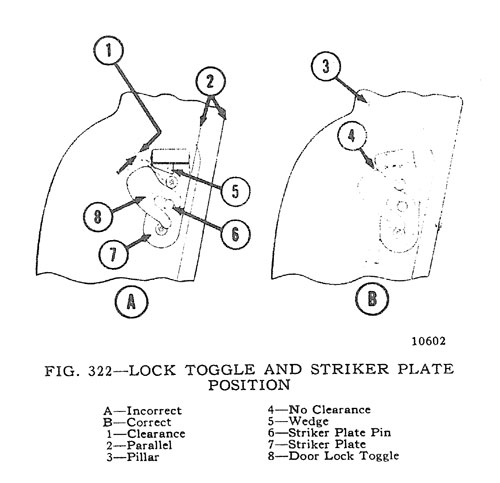
Tail Gate Adjustment
All Utility Wagons. No adjustment is provided for the upper and lower piano type tail gate hinges. Both the upper and lower lock catches mounted on the body pillars are adjustable vertically. Loosen the mounting screws to adjust. The lower tail gate dovetails are adjusted in the same manner.
Tail Gate Hinge Replacement
When replacing the tail gate hinges with the latest type it will be necessary to alter the tail lamp bracket. The alteration consists of increasing the width of the U-shaped opening from 1 5/8" [41 mm.] to 1 3/4" [45 mm.].
Door Locks
The remote control door locks are riveted at assembly and it is recommended that a new assembly be installed should trouble develop. To install a new lock first run the glass up to the closed position and remove the window regulator crank by pressing in the trim ring and removing the retaining pin. To remove the remote control handle, push in on the trim ring and remove the retaining pin. Remove the arm rest and trim panel. Remove the inside door locking knob by unscrewing. Remove two screws from the edge of the door which attach the lower end of the glass runway channel. Place the lock in locked position by turning the forked latch to a vertical position. Remove three screws attaching the remote control to the door panel. Remove four screws attaching the lock to the edge of the door and remove the lock. Reassembly is the reverse of disassembly. It is not necessary to remove the outside door lock handle to remove the lock assembly.
To remove the handle, remove the retaining screw from the edge of the door. Run the glass up to the closed position. If the trim panel has not been removed, loosen the upper corner, directly back of the lock, to spring it back sufficiently to reach in and remove the retaining nut. Should the outside door handle fail to release the door lock easily it is usually due to the trigger in the handle failing to release the lock until it is nearly flush with the handle due to wear or a bent releasing lever on the lock assembly. This condition may be usually corrected without replacement of parts as follows: Remove the inside lining panel as outlined above. Remove the outside door handle and close the door and lock it with inside lock. Measure through the door handle hole the distance from the face of the outside door panel to the face of the releasing lever on the lock assembly. Measure the distance on door handle from the edge of the handle casing to the tip of the boss on the trigger striker lever as shown in Fig. 323. Subtract the two measurements which will indicate the amount the lever boss must be built up to eliminate the lost motion in the trigger. Add slightly more than this amount to the lever boss, indicated by the arrow in Fig. 323, by brazing and dress the brass down to the correct dimension with a file. Lubricate the handle parts and install the handle.
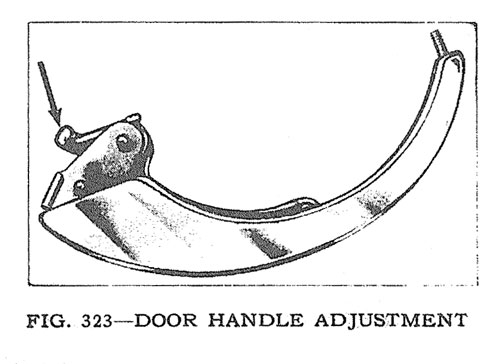
Door Glass Replacement
To remove the door first remove the door lock remote control escutcheon plate by pressing it in and rotating it 1/4 turn counter-clockwise. If equipped with a remote control handle, remove as outlined in "Door Lock,". Remove the regulator crank by pressing in the trim ring and removing the retaining pin. Remove the trim panel and also remove the garnish moulding from a round the glass. Loosen the run channel and remove the regulator control arms from the channel, mounted on the bottom of the glass, by removing the two hair pin type locks which retain the control arm buttons. Remove the glass and runway as an assembly through the window opening.
Window Glass Replacement
Windshield, rear window and quarter window glass is replaced in the same manner on all models. The glass is mounted in a rubber channel or weather seal which is held in position by the rubber garnish moulding and a flange on the body. To remove the glass first remove the garnish moulding. The rubber channel is cemented, for waterproofing, to the body flange and the cement must be loosened. This can usually be done by pressing with the fingers, however, in some cases it may be necessary to use a dull thin blade as a tool. When the cement is loosened the glass and rubber channel can be readily pushed through the opening for removal. To install a glass, first remove the old cement from the rubber channel and body flange. Cement the body flange and glass. Place the rubber channel over the glass and wrap a piece 16" ( 4.76 mm.) rope around the channel. See Fig. 324. Place the glass and channel in the opening and as the assembly is pushed against the body flange pull both ends of the cord out from around the channel. As the cord is pulled the lip of the rubber channel will be pulled out and correctly positioned against the body and over the body flange. Fig. 325.
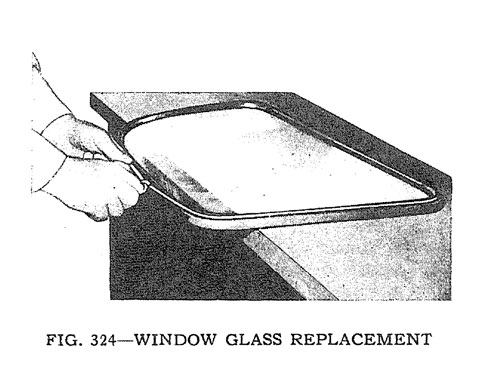
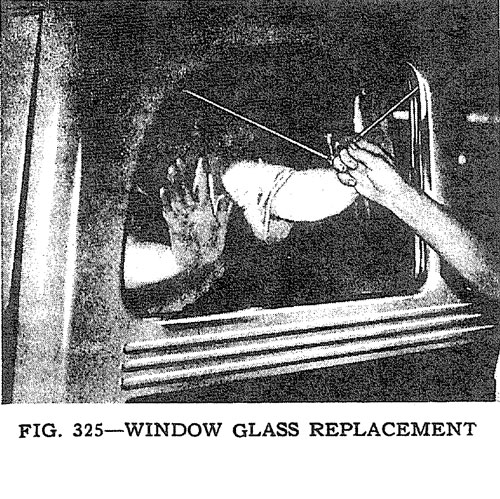
Windshield Glass Replacement
Models with two-piece windshield. To make installation of a windshield glass, it is necessary to first remove the entire windshield assembly. To make a satisfactory installation, both glasses must be installed simultaneously. First, remove the center cover plate from the center bar garnish moulding, the mirror bracket plate, the center bar, the outer cover panel and the two garnish mouldings. Check the packing strip used for attachment of the upholstery to be sure there is no obstruction present which will prevent the free removal of the assembly. Drive in any upholstery tacks which may be protruding and be sure the packing strip is well back in the groove. Have one man work from the front, using a screw driver to work the rubber mounting channel over the body retaining flange. Start at the top center and as the rubber is removed, push in on the assembly to prevent the rubber from working back over the flange. Have a second man support the assembly to prevent its falling in suddenly. After the assembly has been removed, place it on a flat surface with a piece of 1" thick wood under each glass. Remove the glass which must be replaced by working the rubber channel over the edge of the glass. It may be necessary to use a screw driver to loosen the cement seal between the glass and rubber.
Next, install the glass in the rubber mounting channel. The two pieces of glass are interchangeable, however, note that the two corners which are nearly square are placed together with the rounded corners outside. Use a small paint brush to thoroughly coat the channel, which receives the glass, with cement. Place the rubber mounting channel over the glass and work the glass into the channel, being sure it is well-seated. Next, reinstall the windshield assembly in the body, which requires two men. First, mix a strong solution of soap and water and paint the body and mounting flange at all points which contact the rubber. The soap acts as a lubricant to facilitate the installation. Wrap a piece of string at least 1/16" in diameter, but not more than 1/8", around the assembly and in the mounting flange groove as shown in Fig. 326.
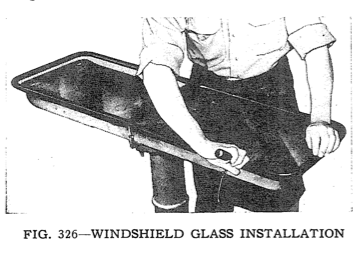
Approximately eight feet of string will be required. Have a man positioned inside the vehicle to place the assembly in the body opening, pressing it in until the rubber contacts the mounting flange. As the assembly is pressed in, have a man on the outside pull the string from the groove to feed the lip of the channel uniformly over the body flange around the windshield. See Fig. 328. After positioning the windshield in the body, cement the rubber mounting channel to the body flange.
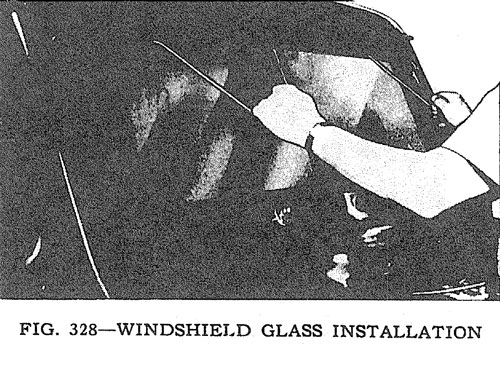
Windshield Glass Replacement
Models with one-piece windshield.
a. Remove and retain the garnish moulding attaching screws, garnish moulding covers, and garnish mouldings. If the vehicle is equipped with a heater, rubber plugs will have been installed under the garnish moulding at each side of both defroster openings. Retain these plugs.
b. Unlock the existing weatherstrip with a weatherstrip locking tool, if available, or a wooden wedge. Carefully remove the windshield. Remove and discard the weatherstrip.
c. Fill the hem flange groove (1) in the new weatherstrip with suitable sealer. Install the weatherstrip on the hem flange with the weatherstrip lock (2) facing outside the vehicle.
d. Install the filler tubing (3) beneath the weatherstrip lip (4) facing inside the vehicle. Locate the 6" [152 mm.] long piece of tubing at the top center of the windshield opening. Locate the 32" [813 mm.] long piece of tubing along the bottom edge of the windshield opening with the ends of the tubing extending beyond the defroster openings in the instrument panel. Install these pieces of tubing before installing the windshield glass.
e. With the weatherstrip unlocked, install the windshield glass in the glass groove (5) of the weatherstrip. Fill the glass groove between the glass and the locking lip with suitable sealer.
f. Lock the weatherstrip in place with a weatherstrip locking tool, if available, or a wooden wedge. For ease of installation, the use of a locking tool is recommended. Remove all excess sealer.
g. Reinstall the garnish mouldings, garnish moulding covers, and defroster rubber plugs (when so equipped). The 1 1/2" [38 mm.] long screws are used along the top; the 1 1/4" [32 mm.] long screws along sides and bottom.
h. If a different type of weatherstrip was previously installed, new garnish moulding attaching holes must be drilled or punched in the instrument panel, door pillars, and header before the garnish moulding can be reinstalled. To drill new garnish moulding attaching holes, use the mouldings as templates. Position the mouldings on the door pillars with mouldings as far as possible to the rear of the vehicle. Drill or punch three .128" [3,251 mm.] diameter holes in each pillar and loosely attach each moulding with three screws. Position the ends of the mouldings at both the top and bottom center of the windshield opening with dimension A at 1/8" to 3/16" [3,175 a 4,763 mm.]. Drill or punch seven .128" diameter holes in the header rail and nine .120" [3,048 mm.] diameter holes in the instrument panel. Then install the garnish mouldings as outlined in step g.
Sliding Window
All Utility Wagons. To remove the sliding window, first remove the garnish moulding. Unclip the glass run channel at each end. Glass and channel are removed as an assembly by tilting in. To remove the sliding window lock it is first necessary to remove the glass as outlined above. Remove the lock handle by removing the retaining pin using a pin punch. Remove the nut directly back of the handle. Remove the trim panel and remove the two screws attaching the lock spring to the body. Fig. 329 illustrates the drain for the sliding window. Be sure the tube is cemented in position and inserted in the body drain hole.
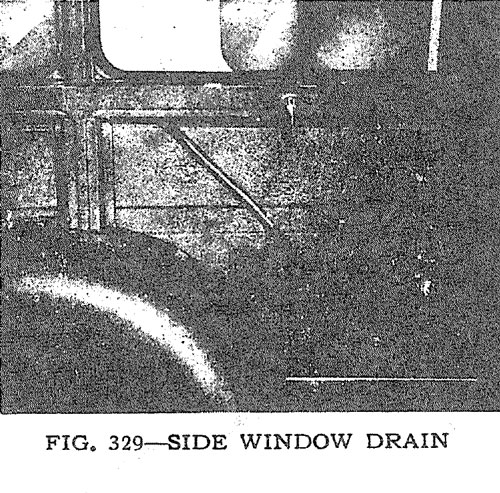
Hood Vibration
Excessive hood vibration may develop on vehicles after long service and may be corrected as follows:
a. Check the hood lock for tight engagement of the locking bolt. Adjust if necessary.
b. Inspect the weatherstrips on the front and rear hood ledge for excessive wear or poor adhesion Replace or recement if necessary.
c. Install new bumpers in place of the two original bumpers on the rear hood ledge at each end of the rear weatherstrip.
d. Apply chalk on top of the new bumpers and close the hood tightly. Open hood and check chalk marks or inner surface of hood. If bumpers are not providing good compression, add flat washers under the bumpers until positive pressure between hood and bumper is obtained.
e. Remove end clips from the weatherstrip on the front hood ledge. Cut 1 1/2" [4 cm.] from each end of the weatherstrip. Make sure the remaining weatherstrip is securely cemented at the ends to the hood ledge.
f. Install two bumpers, one at each end of the front weatherstrip, using the holes left by removal of the end clips. Check for proper compression as outlined in paragraph d. above.
T-23 Windshield Wiper Cable
Two windshield wiper cable tensioners are mounted under the instrument panel. They keep the cables under tension and guide the cables from the wiper motor to the wiper pivot housing. When windshield wiper cables lose tension, overtravel is the result. Overtravel will allow the windshield wiper blades to slap against the windshield center divider bar or lower windshield weatherstrip. There is a limit to the cable slack that can be compensated for by repositioning the arms. Adjustment procedure is to check tension and then reposition arms. Only if these two adjustments do not eliminate the slapping condition should modification in step e be attempted.
a. Be sure bolts which attach each tensioner to the firewall are tight.
b. There is a tensioner for both the left and right wiper. The right tensioner can be seen in Fig. 331. This adjustment can be made on left or right tensioner or both. Loosen, but do not remove entirely, the cable tensioner lock nut on the tensioner bracket. The spring-loaded cable tensioners should then automatically take up any slack in the cables. In some cases it may be necessary to tap the stud lightly to unseat the lockwasher located between the tensioner bracket and base. Then pry the tensioner bracket slightly outboard with a screwdriver to induce cable tensioner springs to take up the slack.
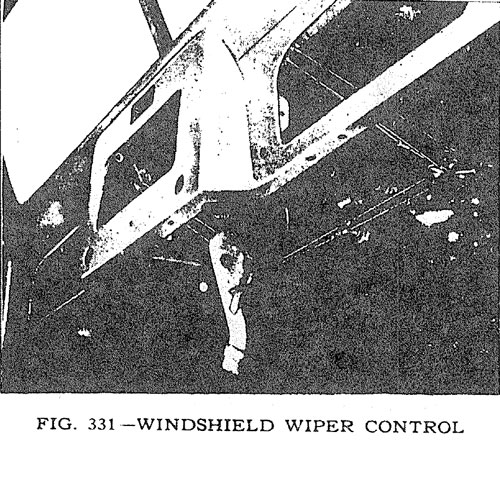
c. Retighten the lock nut firmly to hold the pulleys on the tensioner in the new position.
d. Operate the wipers. If wipers are still slapping, reposition wiper arms one serration at a time until slap is eliminated. Only if slap is not eliminated, modify the tensioners as follows in step e.
e. Elongate the mounting holes in the tensioner bracket toward the center of the vehicle 1/16" [1,6 mm.]. This will let tensioner bracket move outboard an additional 1/16" to provide more tension on the cables.
f. Install tensioner bracket in new mounting position.
g. Finally, check that wiper cables have no interference along their entire travel.
Looking for Body parts for your vintage Willys or Jeep? Search Body by Category or by Diagram
* Excerpt from the Service Manual for Jeep Utility Vehicles page 254
